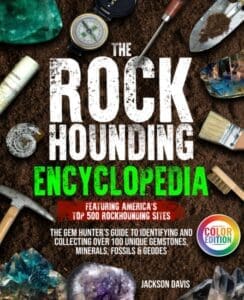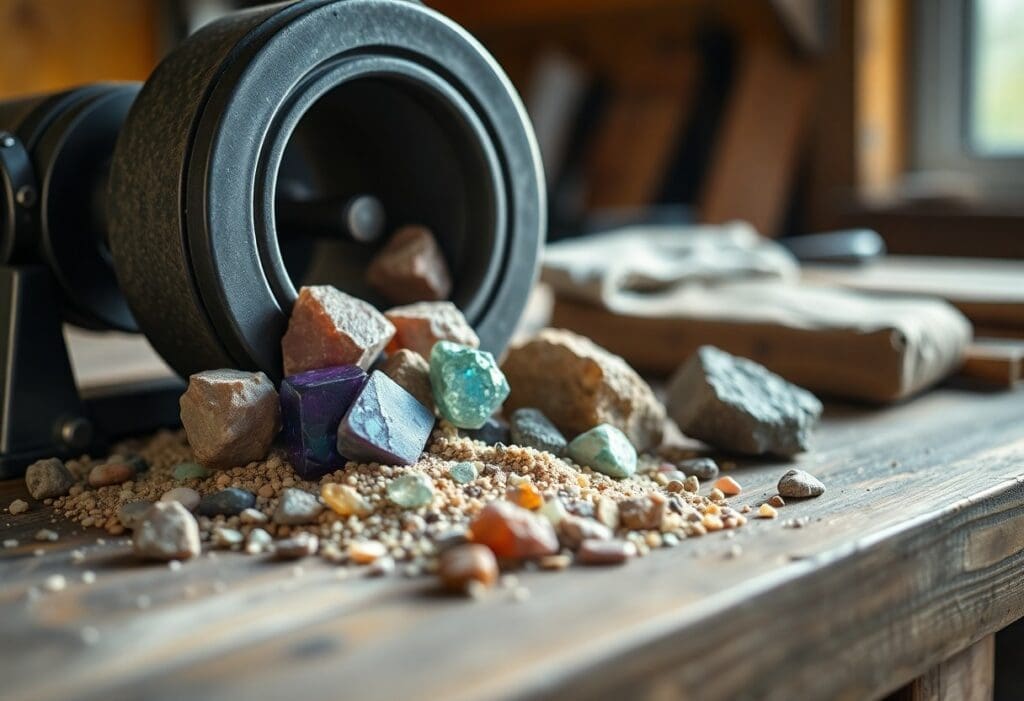Rocks hold a world of beauty just waiting to be revealed, and rock tumbling is the perfect way to uncover their hidden luster. In this guide, you will learn the basics of rock tumbling and polishing, from selecting the right materials to mastering the tumbling process.
With step-by-step instructions and handy tips, you’ll be able to transform rough stones into dazzling gems that showcase your craftsmanship.
Get ready to begin on your rock tumbling journey and discover the satisfaction of creating stunning polished stones for your collection or gifts.
Equip Yourself: The Essential Tools for Rock Tumbling
The Right Tumbler: Choosing Between Rotary and Vibratory
Selecting the right tumbler can significantly impact your rock tumbling experience.
Rotary tumblers, often more affordable, rotate rocks and abrasive grit in a barrel, which offers excellent polishing results over time. In contrast, vibratory tumblers use vibration to provide faster results but may require more attention to prevent damage.
Consider your budget, the type of rocks you want to polish, and how quickly you want results to make the best decision for your needs.
Grits and Powders: The Science of Abrasives
The selection of proper grits and powders is fundamental for effective rock polishing. Grains of different sizes are used at various stages, starting with coarse grits for initial shaping and moving to finer grits for polishing.
Each type of grit has its own specific purpose, helping to refine the stones progressively. Understanding the nuances of these abrasives will greatly enhance your rock tumbling journey.
Initially, you’ll start with a coarse grit, usually around 60-80 grit for shaping rough stones.
As you progress, transitioning to medium grits (often 220) will smooth the surfaces before moving on to fine grits (500 to 1200) for achieving a polished finish.
Using the correct grit at the right time is vital to avoid under-polishing, which can leave your rocks less lustrous, or over-polishing, which can dull the finish.
Safety Gear: Protecting Yourself While Polishing
Solid protective equipment like gloves prevents cuts and scrapes, especially when you’re handling sharp rocks.
Dust masks filter out fine particles that may irritate your lungs, while goggles shield your eyes from any debris that might fly up during the tumbling process.
Investing in reliable safety gear ensures you remain comfortable and safe while enjoying this rewarding hobby.
Selecting Your Rocks: What You Need to Know
Types of Rocks: Best Candidates for Tumbling

In order to achieve the best results in tumbling, you’ll need to get great at choosing rocks.
The stones that tend to yield the most stunning results include agate, jasper, and quartz.
These types have ideal hardness levels, making them suitable for the tumbling process. Here’s a list of recommended stones:
- Agate
- Jasper
- Quartz
- Granite
- Chalcedony
Thou should always aim for harder stones to maximize your tumbling experience.
| Type of Rock | Hardness Level (Mohs Scale) |
| Agate | 7 |
| Jasper | 7 |
| Quartz | 7 |
| Granite | 6-7 |
| Chalcedony | 6-7 |
Avoiding Common Missteps: Incompatibility Issues
Mixing stones of different hardness can jeopardize your tumbling results.
For instance, softer stones can be ground down too quickly by harder ones, leading to unevenly polished stones and an overall disappointing end product.
Analyzing the compatibility of different rocks before starting the tumbling process helps maintain the integrity of each stone. Focus on grouping rocks with similar hardness levels based on the Mohs scale.
Combining rocks with drastic differences can dull your harder stones or leave your softer ones compromised. Keep in mind that the right choice of rocks can make or break your tumbling experience.
Preparing Your Rocks: Cleaning and Sizing Guidelines
Before tumbling, cleaning your rocks is crucial to eliminate any dirt or grime that could hinder the polishing process.
Sizing is equally important; ensure all stones in your tumbler are similar in size to promote uniform tumbling.
Start by rinsing your rocks with water and using a brush for stubborn dirt.
Then, consider the rock sizes: they should be about the same size to ensure even polishing and prevent larger ones from causing damage to smaller rocks.
Providing appropriate preparation will enhance your tumbling journey efficiently.
Understanding the Tumbler Process: Transforming Rough to Polished
Breaking Down the Stages: Coarse to Pre-Polish to Polish
The tumbling process consists of three primary stages: coarse grinding, pre-polishing, and the final polish.
During the coarse stage, you use a rough abrasive to remove sharp edges and shape the rocks. In the pre-polish stage, a finer grit smooths the surface, preparing it for that brilliant shine.
Finally, the polishing stage utilizes a very fine abrasive to bring out the rock’s natural luster and color, transforming it from rough to a beautiful gem.
Timing Is Key: Creating a Successful Schedule
Establishing a clear timeline for each stage is crucial for effective rock tumbling. A well-planned schedule allows you to track progress and ensures that rocks receive ample time for optimal results.
Most tumbling stages take anywhere from one week to a month, depending on the hardness of the rock and the grit used.
Adhering to a consistent schedule helps you avoid under-tumbling or over-tumbling, both of which can compromise the quality of your stones.
For instance, softer stones like alabaster may take a shorter duration than harder ones such as agate.
By noting specific timelines for each rock type, you can better manage your batches and achieve uniform results.
Troubleshooting Common Problems at Each Stage
During the coarse stage, you might notice rocks coming out too small or feeling gritty. This can indicate you either need more time or to adjust your grit size. In pre-polishing, a cloudy surface often signals insufficient time with the grit or a worn-out abrasive.
Finally, if your polished rocks lack shine, it may be due to not using enough polish or the wrong type of polish for your rock.
Keeping a journal of these observations can help you fine-tune the process as you work on subsequent batches.
The Art of Fine-Tuning: Personalizing Your Tumbler Settings
Experimenting with Turns and Mix: Finding Your Groove
Trial and error will guide you to the best rhythm for your tumbler. Start with a standard rotation speed and duration, then adjust according to your specific materials and the results you observe.
Some stones may require a slower tumble to allow for deeper polishing, while others might benefit from a faster cadence. Documenting your findings can help you establish your own preferences over time.
Adjusting Water Levels and Grit Quantities
Water plays a crucial role in the tumbling process, acting as a transport medium for grit and facilitating the removal of debris.
Finding the right balance between water levels and grit quantity can make a significant difference in polishing efficiency.
Start with manufacturer recommendations, then tweak based on your specific experiences and the textured nature of your stones.
Keeping Your Equipment in Top Condition
Regular maintenance ensures your tumbler operates efficiently, prolongs its lifespan, and enhances the quality of your results.
lean your tumbler after each use to prevent grit buildup, which can affect performance.
Pay special attention to the seals and bearings; lubricating them when necessary will help maintain smooth operation and avoid costly repairs.
A well-maintained tumbler results in optimal performance. If you notice uneven polishing or excessive vibration, check for loose parts or abnormal wear. Occasionally, disassemble the tumbler entirely to wipe down the interior and inspect components.
Investing a few moments into upkeep can save you from setbacks and ensure that your tumbler consistently delivers beautifully polished stones.
Unique Techniques for Specialty Stones: Going Beyond the Basics
Handling Soft vs. Hard Minerals: Different Approaches
Tumbling soft minerals, like calcite, requires a gentler touch compared to harder stones such as quartz. For softer stones, you need to reduce the abrasive size or use less vigorous tumbling methods to avoid damage.
Conversely, hard minerals can withstand tougher abrasives and longer tumbling times, allowing you to achieve that perfect polish without fear of scratching the surface.
Enhancements: Adding Treatments for Color and Shine
Enhancing the natural beauty of your stones can bring an entirely new dimension.
Techniques such as dyeing, oiling, or waxing can result in vivid colors and a reflective shine that elevate your polished results.
Each treatment aligns intimately with the stone’s properties, ensuring that the enhancement complements rather than detracts from the rock’s inherent beauty.
Utilizing various treatments, you can significantly alter the appearance of your stones.
Dyes and tints are helpful for enhancing the depth of colors in semi-precious stones like agate or jasper, while oils or waxes can add luster and increase the visual appeal of polished surfaces.
Applying these methods requires care and attention to the stone type, ensuring your enhancements are not only aesthetic but also durable.
Creating Custom Finishes: Advanced Techniques
For those ready to elevate their tumbling game, custom finishes open a world of creative possibilities. Incorporating techniques like sandblasting, buffing, or even laser engraving can dramatically change the look and feel of your polished stones.
Experiment with different approaches to find a finish that resonates with your unique style.
- Sandblasting for textured finishes
- Buffing pads for a high gloss
- Laser engraving for intricate designs
Advanced Custom Finishing Techniques
| Method | Description |
| Sandblasting | Creates a unique, frosted texture by propelling abrasive particles at the stone surface. |
| Buffing | Enhances shine using progressive levels of polishing compounds on a rotating pad. |
| Laser Engraving | Allows for detailed and artistic patterns to be etched onto stone surfaces. |
Incorporating advanced finishes requires practice and experimenting with different techniques to find the right combination for your particular stone.
Consider combining sandblasting and buffing to create a striking contrast between textured and polished areas.
The goal is to develop a signature finish that expresses your creativity while maintaining the integrity and beauty of each stone.
Showcasing Your Creations: Celebrating Success
Effective Display Techniques: How to Showcase Your Polished Rocks
Your polished rocks deserve a stunning display that highlights their unique colors and textures. Consider using clear glass jars or decorative trays to create an eye-catching arrangement.
Natural wood stands or elegant pedestals can elevate their presence, while shadow boxes can protect your stones while adding depth. Think about incorporating LED lights to enhance their shine and bring out the details, ensuring your hard work is front and center.
Crafting with Your Polished Stones: Creative Projects and Inspirations
Combining your polished stones with other materials can lead to unique creations that showcase your personality. Think about making jewelry, such as necklaces and bracelets, or using them in home decor like candle holders or coasters.
Adding your polished stones to plant arrangements also creates a natural aesthetic. Explore these ideas to allow your talents to shine through in everyday items.
Creating jewelry pieces can be particularly rewarding; consider wire-wrapping your polished stones to make stunning pendants or earrings. You can also embed smaller stones in resin for chic coasters or tabletops that reveal your craftsmanship.
DIY home decor can take on new life with a polished stone accent wall or even a decorative garden path. Each creative project becomes an extension of your personality, showcasing your skills and passion for rock tumbling.
Sharing Your Passion: Joining Communities and Competitions
Engaging with others who share your rock tumbling enthusiasm can be a source of inspiration and motivation. Look for local clubs or online forums where you can exchange tips and showcase your creations.
Many places host competitions where you can submit your polished stones for prizes, recognition, and feedback from fellow enthusiasts.
Joining clubs, both local and online, allows you to connect with experts and hobbyists who can offer valuable advice on advanced techniques and troubleshooting.
Competitions can provide great exposure, allowing you to celebrate your successes while also learning from others’ experiences.
Becoming an active participant also opens doors to workshops, exhibitions, and group outings, further enriching your rock tumbling journey.
Cultivating a Rock Tumbling Mindset: The Bigger Picture
The Therapeutic Effects of Rock Tumbling
Engaging in rock tumbling provides therapeutic benefits that extend beyond the mere polishing of stones. The repetitive actions involved in the process foster a sense of mindfulness and help reduce stress.
As you focus on each stage of tumbling, your mind enters a meditative state, allowing daily worries to fade away, creating a mental respite reminiscent of practices like yoga or meditation.
Fostering Patience and Precision: The Skills You Gain
Rock tumbling requires an investment of time and a commitment to precision.
Balancing the right combination of grit, water, and rotation speed demands attentive skill development.
Gradually, you learn to slow down, ensuring each batch receives the care needed to achieve optimal results—this practice of patience can spill over positively into other areas of your life.
By learning to assess your stones’ progress accurately, you cultivate a discerning eye for detail.
Each step in the tumbling process teaches you not just how to manage the equipment but also how to anticipate potential challenges, allowing you to hone your problem-solving skills while deepening your understanding of the materials you work with.
This deliberate practice encourages a mindset that treasures both the journey and the destination.
The Joy of Discovery: Appreciating Nature’s Craftsmanship
Rock tumbling unveils a thrilling journey of discovery that connects you with the intricate artistry of nature. Each stone, with its unique patterns, colors, and textures, tells a story sculpted over millennia.
As you unveil the beauty hidden beneath rough exteriors, you develop a newfound appreciation for the natural world that enriches your experiences outside the tumbler.
This appreciation translates into an experience that goes beyond just polishing rocks; you become invested in the geology behind your materials.
Learning about the formation, mineral composition, and the history of each stone transforms your hobby into a lifelong passion.
It’s a rewarding pursuit that connects you with Earth’s history, igniting curiosity and openness to explore the diverse beauty of your surroundings.
Summing up
Your journey in rock tumbling and polishing involves selecting the right equipment, understanding the necessary materials, and following a step-by-step process for grinding, shaping, and polishing your stones.
As you experiment with different rocks and techniques, you will refine your skills and develop a deeper appreciation for the art of tumbling.
With patience and practice, your commitment will yield beautiful, polished stones that showcase your growing expertise.
Embrace the journey and enjoy the transformation of rough rocks into stunning gems.



